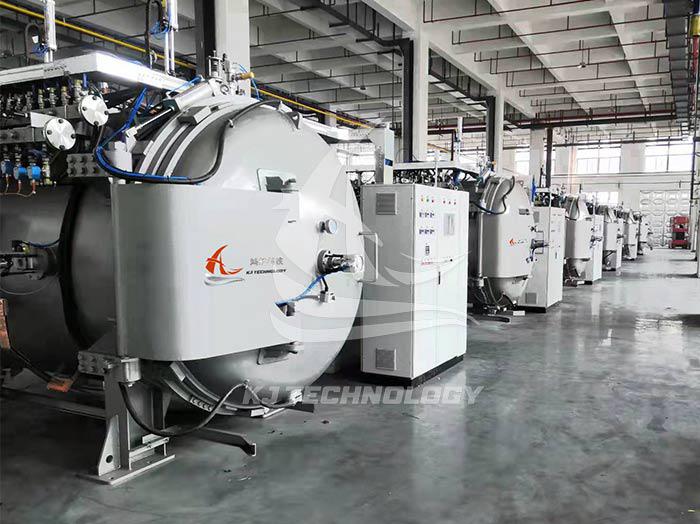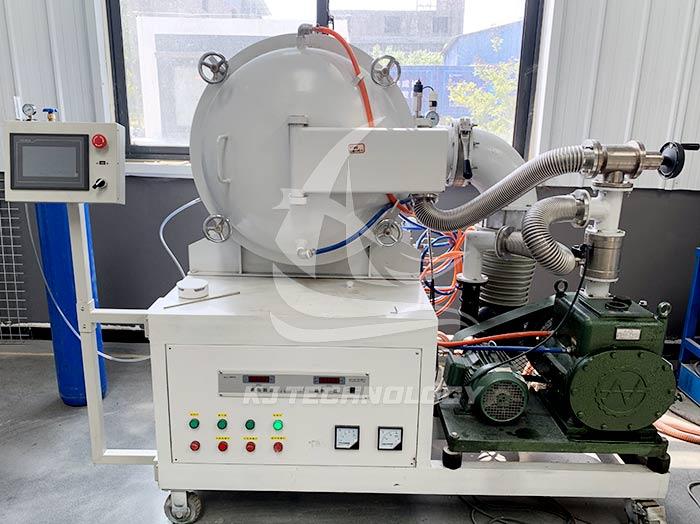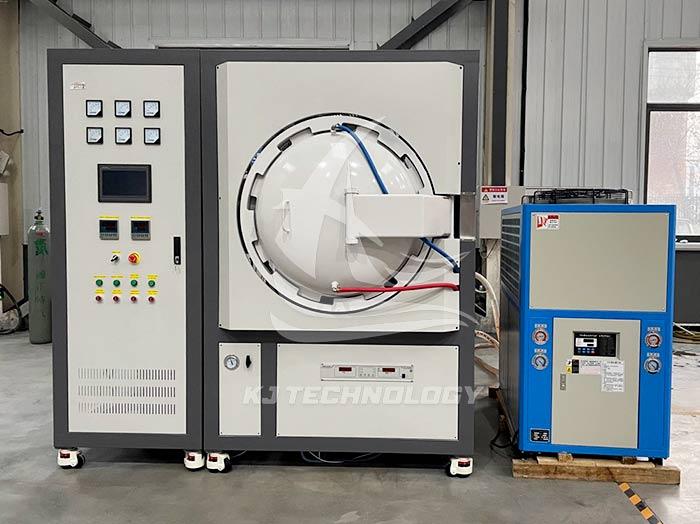Can diffusion welding vacuum furnace brazing metals?
 08-18-2025 Author: KJ technology
08-18-2025 Author: KJ technology
The diffusion welding vacuum furnace can be fully used for metal brazing and has significant advantages in the field of metal brazing. The following is a detailed analysis:
1. The brazing principle of diffusion welding vacuum furnace
The diffusion welding vacuum furnace provides ideal conditions for metal brazing by combining vacuum environment, high-temperature heating, and pressure control:
Vacuum environment:
Eliminate reactive gases such as oxygen and nitrogen in the air to prevent metal oxidation or nitridation at high temperatures, especially suitable for brazing easily oxidizable metals such as aluminum and titanium.
Reduce volatile impurities (such as hydrogen) in the brazing material, avoid defects such as pores and cracks, and improve the quality of the joint.
High temperature heating:
Melt the brazing material and fully wet the surface of the base material, filling the joint gap through capillary action.
Promote element diffusion between the base material and the brazing material, form metallurgical bonding, and enhance joint strength.
Pressure control:
Applying pressure during brazing can improve the contact between the brazing material and the base material, reduce porosity, and increase the density of the joint.
For dissimilar metal brazing, pressure helps alleviate residual stress caused by differences in thermal expansion coefficients.
2. Types of metal materials that can be brazed
The diffusion welding vacuum furnace is suitable for brazing various metals and alloys, including but not limited to:
light metal
Aluminum alloys: such as aviation aluminum alloys (2xxx, 7xxx series), commonly used Al Si and Al Cu brazing materials, have high joint strength and good corrosion resistance after brazing.
Magnesium alloys, such as AZ31 and AZ91, use Mg Zn and Mg Al brazing materials and are suitable for aerospace structural components.
non-ferrous metals
Copper and copper alloys: such as purple copper and brass, commonly used BAg-8 and BCu-80Ag brazing materials, with excellent conductivity, suitable for electronic devices and power equipment.
Nickel and nickel alloys: such as Inconel 625 and Hastelloy C-276, using BNi-2 and BNi-7 brazing materials, high temperature and corrosion resistant, suitable for nuclear industry and chemical equipment.
refractory metal
Titanium and titanium alloys, such as TC4 and TA15, commonly use Ti Zr Ni and Ag Cu Ti brazing materials. The strength of the brazed joint is close to that of the base material, and it is suitable for aircraft engine blades and bone implants.
Tungsten and molybdenum: using Ni based and Co based brazing materials, the high-temperature performance is stable after brazing, suitable for high-temperature furnace heating elements and electrodes.
Heterogeneous metal combination
Aluminum steel: The connection is achieved through Ag Cu Ti brazing material, which solves the problem of brittle intermetallic compounds when aluminum and steel are directly welded, and is suitable for lightweight structures in automobiles.
Copper stainless steel: using BAg-8 brazing material, combined with diffusion treatment, to improve the corrosion resistance of the joint, suitable for heat exchangers and pipeline systems.
Titanium ceramic: such as Ti Al ₂ O ∝, metallurgical bonding is achieved through active metal brazing material (Ag Cu Ti), suitable for hot end components of aircraft engines.
3. Advantages of diffusion welding vacuum furnace brazing
High quality connectors:
Vacuum environment eliminates oxide film, excellent wetting properties of solder, and dense and defect free joints.
The element diffusion is sufficient, forming metallurgical bonding, and the joint strength can reach more than 80% of the base material.
Strong process adaptability:
Complex shaped, thin-walled or dissimilar metal structures, such as honeycomb structures and shell and tube heat exchangers, can be brazed.
By adjusting temperature, pressure, and time parameters, optimizing the brazing process to adapt to different material combinations.
High production efficiency:
Multiple workpieces can be placed simultaneously in the furnace to achieve mass production.
Automated control systems reduce manual intervention and improve production consistency.
Environmental protection and energy conservation:
No need to use flux, reducing harmful gas emissions and meeting green manufacturing requirements.
Vacuum furnaces have good insulation performance and lower energy consumption than air furnaces.
4. Typical application cases
Aerospace field:
Brazing aviation engine turbine blades (titanium alloy+nickel based high-temperature alloy) and satellite structural components (aluminum carbon fiber composite material).
In the field of power electronics:
Brazing high voltage switch contacts (copper tungsten) and transformer windings (copper aluminum).
Automotive industry:
Brazed aluminum alloy radiator and stainless steel exhaust system.
In the field of medical devices:
Brazing titanium alloy artificial joints and cobalt chromium alloy dental implants.








